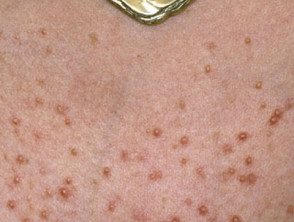What is malassezia?
Malassezia refers to a group of basidiomycetosus (club-shaped) yeasts of the genus Malassezia, which has several different species. The names of the species include:
- M. dermatis
- M. equi
- M. furfur
- M. globosa
- M. obtusa
- M. pachydermatis
- M. restricted
- M. slooffiae
- M. sympodialis
- M. ovalis (also know as Pityrosporum ovale)
What skin conditions are associated with malassezia?
Skin conditions caused or aggravated by infection by malassezia include:
- Pityriasis versicolor: most often due to the subspecies M. globosa, M. sympodialis and M. furfur
Malassezia folliculitis due to yeast growing in the hair follicles where they produce inflammation
- Steroid acne
- Seborrheic dermatitis, dandruff, sebopsoriasis, and facial or scalp psoriasis, most often due to M. restricted and M. globosa.
- Neonatal cephalic pustulosis, a pustular eruption in young babies that resembles infantile acne
- Possibly some cases of confluent and lattice papillomatosis, a pigmented rash that occurs mainly on the chest, back, and neck of adolescent girls
- Some facial atopic dermatitis; in this case there may be specific IgE antibodies directed against Malassezia and positive puncture tests organism
- Rarely, invader pyroporosis in immunocompromised individuals.
Malassezia infections

Malassezia folliculitis

Pityriasis versicolor

Seborrheic dermatitis
How are the skin conditions associated with malassezia diagnosed?
The diagnosis of skin conditions associated with malassezia is often made clinically, but can be confirmed when skin scrapings reveal malassezia (see laboratory tests for fungal infection). Microscopy of malassezia, using potassium hydroxide (KOH) preparations, shows clumps of yeast cells and long hyphae. The appearance is said to be like 'spaghetti and meatballs'. The hyphal filaments used to be called 'Malassezia' and the yeast forms were called 'Pityrosporum', but mycologists eventually realized they were the same organism.
Malassezia species are difficult to culture in the laboratory, so scrapings can be reported as “culture negative ". Yeast grows better if a lipid as olive oil is added to the Littman agar culture medium.
Predisposing factors for malassezia proliferation
Malassezia species inhabit the skin of approximately 90% of adults without causing damage. In some people, yeast suppresses the body's expected immune response, allowing it to proliferate and cause a skin disorder, often with very little inflammatory answer. When malassezia is associated with dermatitis, it is believed to irritate metabolites of yeasts may be responsible (free fatty acids are hydrolyzed from triglycerides)
Predisposing factors for Malassezia skin disease include:
- Humidity
- Sweating: therefore, pityriasis versicolor is common in tropical areas
- Oily skin (seborrhea): therefore, it is mainly found on the scalp, face, and upper torso.
Acne and its treatment with oral antibiotics such as tetracyclines.
Immunodeficiency (eg. HIV infection), systemic corticosteroids or immunosuppression by medications.
Yeasts produce chemicals that reduce the pigment on the skin, causing whitish patches. These include azelaic acid, pityricitrine, and malassezine. However, azelaic acid is a useful treatment for some skin disorders such as acne and rosacea.
Malassezia can fluoresce when exposed to ultraviolet light (Wood's lamp). This is due to another chemical, pityrilactone.
Treatment of skin conditions associated with malassezia
See the DermNet pages on individual skin conditions for treatment information.
In general, malassezia infections are treated with current or oral antifungal agents, such as ketoconazole shampoo and oral fluconazole. Seborrheic dermatitis can also be treated with topical steroids.

